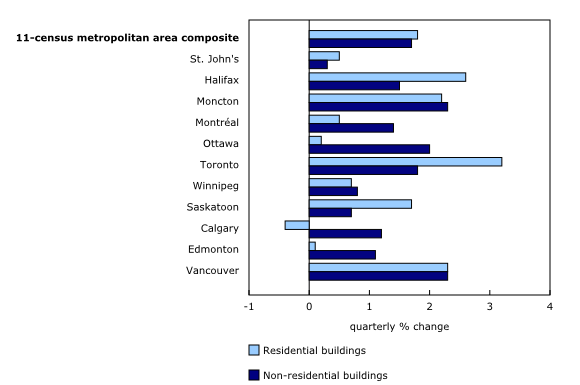Building construction price indexes, first quarter 2023
Released: 2023-05-08
National overview
Residential building construction costs increased 1.8% in the first quarter, following a 1.1% growth in the previous quarter. Non-residential building construction costs rose 1.7% in the first quarter, following a 1.6% increase in the previous quarter.
Year over year, construction costs for residential buildings in the 11-census metropolitan area (CMA) composite rose 11.1% in the first quarter, whereas non-residential building construction costs rose 9.6%. Toronto (+17.7%) led year-over-year growth in construction costs for residential buildings, while Moncton (+14.2%) led growth for non-residential buildings.
Skilled labour shortages and the availability and cost of materials were reported by contractors as key issues across the construction sector.
Toronto leads the rise in residential construction costs
In the first quarter, residential building construction costs rose the most for conveying equipment and masonry (both up 4.0%), and equipment (+3.9%). Wood, plastics and composites (-0.2%) was the only division in residential construction to record a decrease in costs, which can be attributed to the continued decline in lumber prices.
In the 11-CMA composite, the cost to build high-rise apartments (+2.7%) grew the most of all residential buildings in scope for the survey, followed by low-rise apartments (+1.6%).
Costs to construct residential buildings increased the most in Toronto (+3.2%), followed by Halifax (+2.6%) and Vancouver (+2.3%). Calgary (-0.4%) was the only CMA to record a decline in construction costs in the first quarter.
Concrete contributes to the rising cost of non-residential construction
Non-residential building construction costs grew the most for conveying equipment (+3.0%) in the first quarter, followed by equipment (+2.9%) and concrete (+2.8%) divisions. The increase in concrete prices was a major contributor to the rise in costs as concrete is an important component in non-residential construction.
Of all non-residential buildings surveyed, the cost to build office buildings and warehouses (both up 1.8%) rose the most in the 11-CMA composite.
Costs to construct non-residential buildings increased the most in Moncton and Vancouver (both up 2.3%), followed by Ottawa (+2.0%).
Note to readers
The building construction price indexes are quarterly series that measure the change over time in the prices that contractors charge to construct a range of commercial, institutional, industrial and residential buildings in 11 census metropolitan areas (CMAs): St. John's, Halifax, Moncton, Montréal, Ottawa–Gatineau (Ontario part), Toronto, Winnipeg, Saskatoon, Calgary, Edmonton, and Vancouver.
These buildings include six non-residential structures: an office building, a warehouse, a shopping centre, a factory, a school, and a bus depot with maintenance and repair facilities. In addition, indexes are produced for four residential structures: a single-detached house, a townhouse, a high-rise apartment building (five storeys or more) and a low-rise apartment building (fewer than five storeys).
The contractor's price reflects the value of all materials, labour, equipment, overhead and profit to construct a new building. It excludes value-added taxes and any costs for land, land assembly, building design, land development and real estate fees.
With each release, data for the previous quarter may have been revised. The index is not seasonally adjusted.
With the release of data from the fourth quarter of 2022, table 18-10-0135 has been archived and replaced by table 18-10-0276. The information that was in table 18-10-0135 is still in the new table. However, the new table also shows data by construction division. Data are now available for 23 divisions and for a composite of these divisions. Newly integrated divisional data are available starting from the first quarter of 2017.
Products
The Building Construction Price Indexes Data Visualization Tool is now available. It provides access to current and historical data from the Building Construction Price Index (BCPI) for four residential and six non-residential building types, for the CMAs of St. John's, Halifax, Moncton, Montréal, Ottawa–Gatineau (Ontario part), Toronto, Winnipeg, Saskatoon, Calgary, Edmonton, and Vancouver as well as for a composite of these 11 CMAs, in a dynamic and customizable format.
The Technical Guide for the Building Construction Price Index is now available. This document provides details on the methodology used to calculate the BCPI.
Statistics Canada launched the Producer Price Indexes Portal as part of a suite of portals for prices and price indexes. This webpage provides Canadians with a single point of access to a wide variety of statistics and measures related to producer prices.
The video "Producer price indexes" is available on the Statistics Canada Training Institute webpage. It provides an introduction to Statistics Canada's producer price indexes—what they are, how they are made, and what they are used for.
Contact information
For more information, or to enquire about the concepts, methods or data quality of this release, contact us (toll-free 1-800-263-1136; 514-283-8300; infostats@statcan.gc.ca) or Media Relations (statcan.mediahotline-ligneinfomedias.statcan@statcan.gc.ca).
- Date modified:


